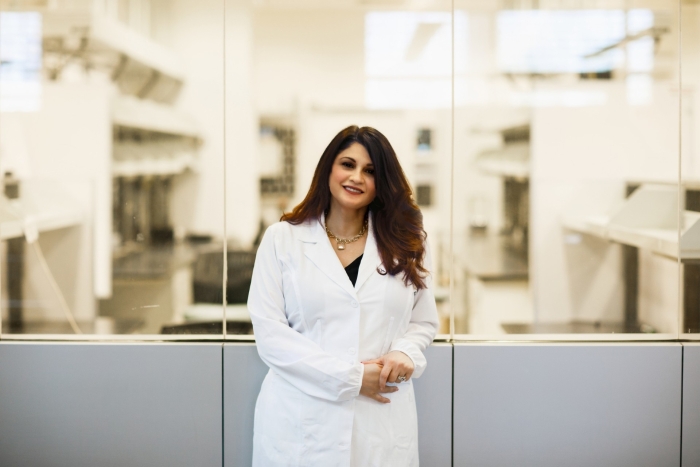ASU research finds link between removal of uterus, brain function

ASU scientists found that removing the uterus may impact brain function — part of growing evidence that the uterus is much more important to female health than we thought. Illustration by Ana Hernandez
The uterus has three clear jobs: periods, pregnancy and labor. At least, that’s what the medical textbooks tell us. But new research is suggesting the organ may play a bigger role in female health.
According to the Centers for Disease Control and Prevention, around one quarter of all women in the U.S. have their uterus (also called a womb) surgically removed by the age of 65 in a procedure known as a hysterectomy.
A 2014 study found that nearly 1 in 5 hysterectomies had no supportive reason, and nearly 2 in 5 patients receiving hysterectomy did not undergo alternative treatments before the procedure.
Hysterectomy is the second most common surgery for women after the C-section. While it is necessary in some cases to treat cancer, it’s also used widely for often-debilitating conditions like abnormal bleeding or uterine fibroids.
But a growing body of research is revealing that the uterus is more of a powerhouse organ than previously thought, with connections to the immune system and heart. Now, scientists from Arizona State University have added to this evidence with their recent finding that the uterus — and its removal — may have a direct impact on brain function.
For those who have already undergone a hysterectomy, this research is still good news: Understanding the effects of the procedure can help inform treatment options for post-procedure symptoms and improve overall quality of life.
The uterus–brain connection
Heather Bimonte Nelson, an ASU President’s Professor in the Department of Psychology, is an expert in cognitive function and aging, especially as it relates to menopause and hormones. She directs the Behavioral Neuroscience of Memory and Aging Lab, which investigates the roles that sex, hormones and brain chemistry play in brain function and cognition at different ages.
As she and her team researched the ways hysterectomy affects the mind, Bimonte-Nelson found clues that suggest a possible connection between the uterus and the brain. In her initial study, the team used a water maze to test rodents’ cognitive function after a hysterectomy and found that those that had the uterus (but not the ovaries) removed had impaired working memory six weeks later.
But did this effect continue long term? And was removal of the uterus itself the cause, or did it come from a change to the ovaries after hysterectomy?
Bimonte-Nelson’s follow-up study sought to answer these questions. She showed that the impaired memory persisted after six weeks, six months and even one year. In the time since the initial study, her team has replicated findings of hysterectomy-induced cognitive changes four times.
She also demonstrated that hormone levels and ovarian tissues did not show any significant systematic changes in those time frames.
“Hysterectomy-induced memory changes, even 12 months later, don't seem to be driven by a change from the ovaries, which really is leaning into the suggestion that there's a uterus–brain connection that is not yet known and impacting specific cognitive functions,” Bimonte-Nelson says. “That's what we're working really hard on figuring out right now.”
Because one year for a rat is roughly the same as 30 years for a human, this research suggests that hysterectomy can have a long-lasting effect on memory. However, Bimonte-Nelson stresses that she doesn’t want to fill women with dread, especially if they’ve already had a hysterectomy. Rather, she hopes to put power back in their hands.
“If a patient has a certain set of symptoms, the doctor could link it back to the prior hysterectomy. This research could also tell us why patients have this set of symptoms in common and may help us find ways to improve quality of life after hysterectomy,” she says.
Females are not a deviation from normal
Our lack of comprehensive knowledge about the uterus is a symptom of a larger historical problem in medical science.
“The feel of the literature is that what happens in males is normal, and what happens in females is a deviation from normal. This is a huge issue, and it's a disservice not just to females, but also to males,” Bimonte-Nelson says.
In the past, and even today, most studies focused on males or ignored sex factors by blending data from males and females. But this can have a disastrous impact on health treatment outcomes.
That’s because males and females often respond to drugs differently and have different symptoms for the same illness. Excluding females from studies means they are more likely to be misdiagnosed or have more side effects from a drug. Not accounting for sex at all leaves both sexes with less effective medical help.
For most of the 20th century, heart attack diagnosis was based on men’s symptoms and thereby missed signs of heart attack in women, often with deadly consequences. Recent decades have seen a push for better education for women and their doctors to recognize heart attacks in women and protect women’s heart health.
But why ignore female data in the first place? The common excuse is that the menstrual cycle causes changes that affect test results, making females more difficult to study.
“Just because it’s hard doesn’t mean we should not study it, or that it is not important,” says Bimonte-Nelson. “Many have argued that it is too complex and not within the realm of their question. That means that the only question left is relevant to males, and that’s a problem.”
Females are not just a variance of a male norm, Bimonte-Nelson says. They are an essential part of humankind, and therefore an essential part of science.
“We cannot study half of the population, leaving out women, and think that we are accomplishing accuracy and excellence in science and medicine,” she says. “New data are giving us insight into how the uterus is a powerhouse organ, and it is our job as scientists to understand it.”
Toward better patient care and medical science
Since much of our medical knowledge comes from studies on males, researchers are going back to basics to intentionally learn how the female body works. Doing so will build a better foundation for health research going forward.
In Bimonte-Nelson’s lab, undergraduate research assistants are taking this perspective with them as they move on to medical school and related careers. Seven students from the lab graduated this spring.
“I’m so proud of my students and how dedicated they are to studying these questions,” Bimonte-Nelson says. “Several of them have gotten into med school, and many of them are leaning into this tenet that, as physicians, they have to understand the science of both males and females in order to be the best clinicians that they can be to help patients.”
Undergraduate student Sadaf Asadifar used her work in Bimonte-Nelson’s lab as the basis for her honors thesis, which studied how sex hormones affect cognitive and brain changes during aging. Asadifar, who came to the U.S. with her family as a refugee, was recognized as the Barrett Honors College Outstanding Graduate for spring 2024. She hopes to become a cardiothoracic surgeon.
We must have the courage to keep moving scientific discovery into uncharted territories and overturn dogma when the science tells us to.
Heather Bimonte-NelsonPresident’s Professor, Department of Psychology
As Bimonte-Nelson shapes the next generation of health care professionals, she is also expanding the science of hysterectomy and memory along with her ASU collaborator, Associate Professor Jason Newbern. Their research project studies how hysterectomy changes the brain’s neurotransmitter systems.
"Our groups are thrilled to join forces to uncover the underlying biological mechanisms of this intriguing and poorly understood relationship between uterine and cognitive processes,” says Newbern, who works in the School of Life Sciences. “For example, we have yet to detect an acute loss in the subtypes of neurons that have been examined thus far. Instead, our data indicate there may be chronic functional changes in select forebrain circuits. Further investigation into the molecular abnormalities associated with these circuits could help identify potential biomarkers for clinical studies or inform the development of preventative strategies."
As they explore the uterus–brain connection, Bimonte-Nelson and Newbern’s teams will grow our understanding of this long overlooked and underappreciated organ.
Ultimately, studies that illuminate female health after hysterectomy will arm doctors and their patients with more opportunities to improve health. More women may choose to keep their uteruses whenever possible, or they may simply have a better understanding of their bodies after hysterectomy. Meanwhile, researchers can develop therapies to improve outcomes after this procedure, which doctors can then provide.
“The more we understand about the female body, the more women and their doctors can make informed decisions about the possible consequences of removing a gynecological structure that has been traditionally described in medical texts as dormant and useless when not carrying a fetus,” Bimonte-Nelson says. “We must have the courage to keep moving scientific discovery into uncharted territories and overturn dogma when the science tells us to.”
This work is funded by the National Institute on Aging (AG028084), NIH Alzheimer's Disease Core Center (P30AG019610) and the Arizona Department of Health Services (ADHS14-052688).
More Health and medicine

Hurricane changed 'rules of the game' on Monkey Island to foster more cooperation
In 2017, Hurricane Maria became the largest catastrophe in the history of Puerto Rico, killing over 3,000 people, knocking out power to nearly all of the island and causing more than $100 billion in…

Lessons from HIV/AIDS: ASU dean reflects on advancing research of public value
The first known cases of acquired immunodeficiency syndrome (AIDS) in the United States were documented in a June 5, 1981, Morbidity and Mortality Weekly Report published by the U.S. Centers for…

Developing tools for positive parenting in face of 21st-century challenges
Top ASU psychology professors with expertise in trauma-informed parenting interventions have joined with the Child Mind Institute to develop videos and tools to directly help families dealing with…
